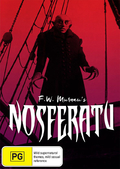Nosferatu (Nosferatu, eine Symphonie des Grauens) (Bounty Films) (1922) (NTSC) |
|
Nosferatu (Nosferatu, eine Symphonie des Grauens) (Bounty Films) (1922) (NTSC) |
|


|
| BUY IT |
| General | Extras | ||
| Category | Horror |
Audio Commentary-with film critic John Noonan More…-Dante’s Inferno (1911) (62:32) Short Film-Selection of Silent Horror Shorts (1896-1903) |
|
| Rating |

|
||
| Year Of Production | 1922 | ||
| Running Time | 93:13 (Case: 81) | ||
| RSDL / Flipper | Dual Layered | Cast & Crew | |
| Start Up | Menu | ||
| Region Coding | 1,2,3,4,5,6 | Directed By | F.W. Murnau |
|
Studio
Distributor |
Gryphon Entertainment | Starring |
Max Schreck Gustav von Wangenheim Greta Schröder Alexander Granach Georg H. Schnell Ruth Landshoff John Gottowt Gustav Botz Max Nemetz Wolfgang Heinz Albert Venohr |
| Case | Amaray-Transparent | ||
| RPI | ? | Music | Hans Erdmann |
| Video (NTSC) | Audio | ||
| Pan & Scan/Full Frame | None |
Isolated Music Score Dolby Digital 2.0 mono (224Kb/s) English Audio Commentary Dolby Digital 1.0 (192Kb/s) |
|
| Widescreen Aspect Ratio | None | ||
| 16x9 Enhancement | No | ||
| Video Format | 480i (NTSC) | ||
| Original Aspect Ratio | 1.33:1 | Miscellaneous | |
| Jacket Pictures | No | ||
| Subtitles | None | Smoking | No |
| Annoying Product Placement | No | ||
| Action In or After Credits | No | ||
Nosferatu (or in full Nosferatu, eine Symphonie des Grauens) is the silent German expressionist film from 1922 directed by Friedrich Wilhelm Murnau that is the grandfather of all vampire films. Despite being called Nosferatu, this is a film of Bram Stoker’s Dracula with changed names but as the rights were never obtained a court case resulted in the destruction of most of the film’s original prints; however the film did survive and there have been numerous home video releases of Nosferatu around the world with commentaries, extras and restored versions of the film. For a comprehensive explanation of all things Nosferatu, including the different versions, see the article here. For a comparison of some of the best versions including screen shots see the DVDBeaver review here. There was also an excellent release of the film in Australia by Madman some years ago, although it is now no longer in the Madman catalogue; it’s review on this site by TrevorD can be found here.
To the story: Hutter (Gustav von Wangenheim) leaves his young wife Ellen (Greta Schroeder) in Wisborg, a port in the north of Germany, and is sent by estate agent Knock (Alexander Granach) to Transylvania to the castle of Count Orlok (Max Schreck) to complete a real estate purchase that Orlok has made in Wisborg. In Orlok’s castle Hutter makes some disturbing discoveries, including waking up with two bite marks on his neck he thinks were made by mosquitoes and later finding the Count sleeping in a coffin! Leaving Hutter trapped in the castle, the Count embarks in his coffin on a ship through the Black Sea to Wisborg; in each port the ship docks the plague breaks out and people die. When the ship arrives in Wisborg the crew are all dead or missing; Orlok disembarks unseen and goes to the house he has purchased across the street from the Hutter’s house, and watches Ellen. The plague now spreads in Wisborg causing fear and many deaths. Meanwhile, Hutter has escaped and hurried back to Wisborg to be reunited with Ellen, who realises she is being watched by Orlok from across the road. She finds a book which explains that a vampire can only be destroyed by a virtuous woman offering her blood to distract the vampire until the cock crows. She sends her husband on an errand and leaves the way open for Orlok and as he feeds the sun comes up and he dissolves.
Nosferatu is a gem of a film which deserves its cult status. Murnau’s use of light and shadow is exceptional and scenes such as the vampire framed in the doorway, the menacing shadows as Orlok climbs the stairs or a mad Knock catching and eating flies have influenced filmmakers for generations. Max Schreck, as the Count, is on screen for only about nine minutes but he is mesmerising. He is certainly not a model for the more recent “sexy” vampires: he is pale, thin and rat-like with pointy ears and he has a stillness whenever he appears that still produces dread. He is, in a word, perfect in the part and so good he could have been a real vampire (as the excellent 2000 film, Shadow of the Vampire with Willem Dafoe as Schreck and John Malkovick as Murnau, tells us).
Most film fans are likely already to have a copy of the film. So what is the source of this new release from Bounty and does it have anything new to offer?
The first question is difficult to answer as the DVD box cover and the distributors provide no information. However, what we get is the full 94 minute version of the film (the DVD case indicates a running time of 81 minutes which is incorrect) complete with the Overture and the Hans Erdmann score in Dolby Digital 2.0 mono at 224 Kbps. The film is NTSC and is properly tinted, with yellow, blue, pink and mauve sections as well as black and the intertitles are the English version. Overall this print looks good and is very similar to the Kino disc 1 screenshots on the DVDBeaver site.
What is different is the extras which are exclusive to this Bounty release. First is a good commentary by Australian film critic John Noonan recorded specifically for this DVD. The other extras are not related to Nosferatu but are nevertheless fascinating for film buffs: Dante’s Inferno (62:32) from 1911, said to be the “world’s oldest surviving feature-length film”, and nine silent horror short films made between 1896 and 1903. See the extras section below for more details.
Nosferatu is presented in a ratio of 1.33:1, in the NTSC format. My computer reads the film as 16x9; however it does display in the proper 4x3 ratio on my widescreen TV.
I was very pleased by the way the print looked. Sharpness varied; it is often very good but even when it was softer it was still reasonably clear. Not surprisingly, there are dirt marks, mostly very small, vertical scratches and frame jumps but artefacts such as interlacing or macro blocking are absent. The film is tinted with blue, yellow, mauve and pink sections so blacks while not pristine are acceptable. Brightness and contrast fluctuate.
The English intertitles were easy to read. White English titles came on automatically to translate some sections of German text, such as the ship’s log.
The layer change at 55:59 resulted in a slight pause just after a scene change.
The scores for the film have been adjusted as one cannot judge a film of this age against modern films.
| Sharpness | |
| Shadow Detail | |
| Colour | |
| Grain/Pixelization | |
| Film-To-Video Artefacts | |
| Film Artefacts | |
| Overall |
Audio is Dolby Digital 2.0 mono at 224 Kbps plus the audio commentary, Dolby Digital 1.0 at 192 Kbps.
As a silent film, there was no dialogue or effects to comment on! The score was nicely rendered and I did not notice hiss or hum.
Obviously there are no lip synchronization issues.
| Dialogue | |
| Audio Sync | |
| Clicks/Pops/Dropouts | |
| Surround Channel Use | |
| Subwoofer | |
| Overall |
There extras are fascinating although, except for the commentary, none have a connection with Nosferatu.
The commentary was recorded for this Bounty release. Australian film critic John Noonan chats to Leslie Morris; this is a chatty, entertaining and informative commentary, although occasionally they laugh too much. They discuss German expressionism, the name of the film, the life, death and career of director F W Murnau, Max Schreck, vampire mythology, the court case with Bram Stoker’s widow which led to most prints of the film being destroyed, the influence of the film and remakes.
This film is advertised on the DVD cover as being the “world’s oldest surviving feature-length film”; it was made in Italy in 1911 and is also known as L’Inferno. The Roman poet Virgil Arturo Pirovano takes Dante Salvatore Papa on a journey through the circles of hell. This print looks rather better than I expected for a film that is over 100 years old!! The print is soft and has plenty of marks, artefacts and scratches, frame jumps, flickers and brightness and contrast variations yet, except in a couple of sequences, it is quite watchable. Intertitles are in English. The draw for those interested in film is to watch the techniques that were being used when filmmaking was it its infancy. Dante’s Inferno uses static cameras in long takes without pans; these are all medium or long shots, with no close-ups except for one at the end of Lucifer Augusto Milla eating a sinner! However the in-camera special effects are fascinating; wire work as characters fly around, puppets, double exposures, dissolves and superimposed figures were film techniques used for decades until the advent of CGI. Dante’s Inferno also includes a surprising amount of bare flesh and male and female nudity. This print has a piano theme which is repeated, and repeated, and repeated, quickly becoming annoying, but I guess you can always turn the sound off!
Talk about a treasure trove of early silent shorts! They are in various stages of repair with numerous marks and a wide range of artefacts; some are very blurred, others reasonably firm, a couple are colourised. The Devil appears often; some are quite amusing and rather than horror as such the main interest in most is the experimentation by the filmmakers with in-camera tricks and illusions such as intercutting, jump cuts, forced perspectives and the like. All are NTSC with different music, often classical (Dolby Digital 2.0 mono at 192 Kbps). There is a Play All option, but note that if using this option the shorts do not play in the same order as shown on the menu. The shorts are:
NOTE: To view non-R4 releases, your equipment needs to be multi-zone compatible and usually also NTSC compatible.
There are some excellent releases of Nosferatu in various regions with extras relevant to the film. This Bounty release does however include extras not available elsewhere.
A silent expressionist film released in 1922, Nosferatu is the father of all subsequent vampire films and its influence continues to resonate today. The video is surprisingly good, the audio acceptable.
Many releases of Nosferatu have better and more relevant extras than this new release and film buffs and fans of the film will already have a copy. Your interest in this Bounty release will be based on your interest in the extras. However, if you don’t have a copy of Nosferatu this is your chance.
| Video | |
| Audio | |
| Extras | |
| Plot | |
| Overall |
| Review Equipment | |
| DVD | Sony BDP-S580, using HDMI output |
| Display | LG 55inch HD LCD. This display device has not been calibrated. This display device is 16x9 capable. This display device has a maximum native resolution of 1080p. |
| Audio Decoder | NAD T737. This audio decoder/receiver has not been calibrated. |
| Amplification | NAD T737 |
| Speakers | Studio Acoustics 5.1 |